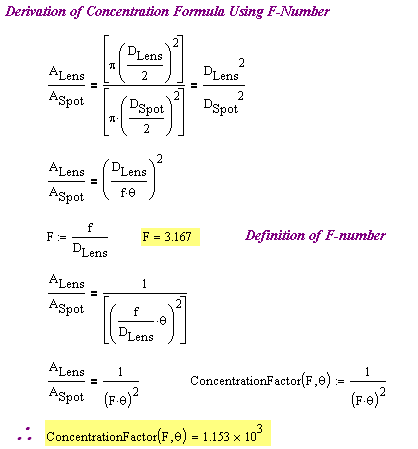Introduction
My favorite radio program is Science Friday. Last week, their web page included an excellent video where Science Friday's resourceful intern, Flora Lichtman, gave a wonderful explanation behind the use of a lens to concentrate the Sun's power. Her assistant in this effort was Thomas Baer, Executive Director of the Stanford Photonics Research Center (i.e. big shot). Here is a link to the video.
http://www.sciencefriday.com/embed/video/10380.swf
During the demonstration, they did bit of math that showed how a person could compute the level of solar power concentration provided by a simple magnifying glass. In a manner totally appropriate for this kind of video, they magically pulled out an equation and a value for the angular diameter of the Sun (Flora did say to look up the angular diameter of the Sun in any physics textbook). I thought it would be worthwhile to derive both the equation and the angular diameter of the Sun. Let's dig in ...
Analysis
During the video, Thomas Baer wanted to give a simple, approximate formula for the concentration factor of solar power provided by a common magnifying glass. He gave the formula shown in Equation 1.
| Eq. 1 |
where F is the F-number of the lens. The F-number of the lens is defined as , where f is the focal length and DLens is the diameter of the lens. For the lens in their example, they computed an F-number of about 3.16, which means the concentration factor is 1000. This means that the power at the spot is the same as what entered the lens, but it is concentrated on an area 1000 times smaller.
I want to derive Equation 1 from first principles. We can start with Figure 1, which illustrates the geometry of the situation.
Determination of the Angular Diameter of the Sun
Figure 2 illustrates how to calculate the Sun's angular diameter at the Earth (Ө). I used Google to get the Sun's diameter (DSun) and distance (RSun).
This analysis agrees with the value listed in the Wikipedia.
Concentration of Solar Power From First Principles
Figure 3 shows my calculation for the magnifying glass' concentration of solar power. I make the assumption that we can approximate the diameter of the spot by using , where Ө is the angular diameter of the Sun.
Concentration of Solar Power Using F-Number
Figure 4 shows my derivation of Equation 1. It is straightforward and gives the same numerical answer as above. The only difference from what Flora and Tom obtained occurs because my angular diameter is a bit different than theirs. Of course, they were using approximate numbers.
Conclusion
Flora and Tom did a nice job on the video. I wanted to walk through it and make sure that I understood mathematically what was going on. I believe that I do.
P.S.
If you want to see what you need to start a leaf on fire with a lens, see this post.





Hi! I really enjoyed reading this and I found you elucidated your derivation very well. I ended up using your calculations to go one step further and calculate how long it would take a convex lens to cause a piece of paper to ignite. I worked out the equations and numbers here if you are interested: https://www.facebook.com/notes/teddy-levine/starting-a-fire-with-a-magnifying-glass/10152800491583466.
Thanks again!
I really like what you did! I will add a link to your page. Nice work!
mathscinotes